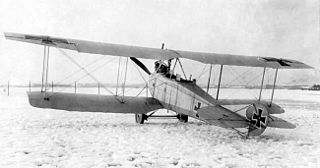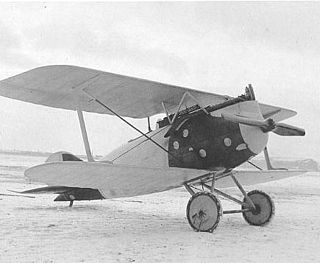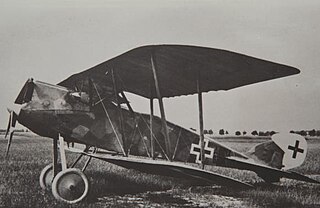
The Aviatik C.I was an observation aircraft which came into service during World War I in April 1915. It was a development of the Aviatik B.I and B.II models, being one of first aircraft of the new German C class of armed biplanes. In the C.I the observer sat in front of the pilot, with a machine-gun clipped on a sliding mounting fitted on a rail at either side of the cockpit. It gave the crew the means to attack enemy aircraft. The positions of the pilot and observer were reversed in last series of 50, ordered in 1917 solely for trainer purpose. There was only one aircraft built of refined C.Ia version in May 1916, with armament still in a forward cab, serving as a prototype for C.III. Later models of the plane included the Aviatik C.II and the C.III, which had more powerful engines. The C.III was produced in large numbers.

The LVG C.VI was a German two-seat reconnaissance and artillery spotting aircraft used during World War I.

The Halberstadt C.V was a German single-engined reconnaissance biplane of World War I, built by Halberstädter Flugzeugwerke. Derived from the Halberstadt C.III, with a more powerful supercharged 160 kW (220 hp) Benz Bz.IVü engine, it saw service only in the final months of the war. Cameras were mounted in the observer's cockpit floor.

The DFW C.IV, DFW C.V, DFW C.VI, and DFW F37 were a family of German reconnaissance aircraft first used in 1916 in World War I. They were conventionally configured biplanes with unequal-span unstaggered wings and seating for the pilot and observer in tandem, open cockpits. Like the DFW C.II before them, these aircraft seated the gunner to the rear and armed him with a machine gun on a ring mount. Compared to preceding B- and C-class designs by DFW, however, the aerodynamics of the fuselage were more refined, and when coupled with more powerful engines, resulted in a machine with excellent performance.
The DFW R.I,, was a prototype German bomber aircraft of World War I.

The Rumpler B.I was a military reconnaissance aircraft produced in Germany during World War I.

The Rumpler D.I was a fighter-reconnaissance aircraft produced in Germany at the end of World War I. It was a conventional single-bay biplane with wings of unequal span braced by I-struts. It featured an open cockpit and a fixed, tailskid undercarriage. The upper wing was fitted with aerodynamically balanced ailerons and fuselage had an oval cross-section.

The Rumpler G.I was a bomber aircraft produced in Germany during World War I, together with refined versions known as the G.II and G.III.

The Aviatik D.II was a prototype German single-seat biplane fighter aircraft built by Aviatik during World War I. Only a single aircraft was built, but no production order followed. It later had its conventional wings replaced by bird-shaped wings and has been referred to as the Geest Fighter in this guise. Further development was discontinued.
The Aviatik C.V was an experimental reconnaissance biplane with a distinctive gull like upper wing. Not to be confused with the DFW C.V which was licence built by Aviatik as the Aviatik C.VI.
The Aviatik D.III was a German prototype single-seater fighter plane from the First World War, designed by Aviatik. It became the basis for the Aviatik D.IV and Aviatik D.V. In November 1917, the plane was first flown, using a 195 hp Benz Bz IIIbo gearless engine. It was of similar design to the Aviatik D.II, and was armed with two LMG 08/15 machine guns. After several tests at Adlershof from February 9–12, 1918, the plane underwent modifications, as requested by the Idflieg. In April, a second prototype, powered by a Benz Bz IIIbm, although several D.III powered by the original IIIbo engine were already under production; however, none of them were ever completed.

The Otto C.I, also known as the Otto KD.15, was a German two-seat biplane reconnaissance and bomber aircraft of the First World War designed and produced by Otto Flugmaschinenfabrik. The C.I was a rare example of an aircraft flown by the Central Powers which had a pusher configuration.

The Aviatik D.VII was a prototype German single-seat biplane fighter aircraft built by Aviatik in the last year of the First World War. It could not participate in the Third Fighter Competition of October 1918 because it used the wrong engine and it saw no military service, although 50 aircraft were found in storage after the war. The only real major change from the earlier Aviatik D.VI was a completely new tail structure.

The Zeppelin-Lindau CS.I was a German single-engined reconnaissance seaplane with a low-wing monoplane layout.

The Aviatik C.IX was a prototype German observation aircraft built by Aviatik in the final months of World War I.
The Aviatik C.VIII was a prototype German observation aircraft built by Aviatik in World War I.
The LVG G.I,, was a prototype German bomber aircraft built by LVG during World War I.
The Aviatik D.VI was a German prototype single-seater fighter aircraft of the First World War, designed by Aviatik.
The LVG C.VIII was a prototype reconnaissance aircraft built in Germany during World War I.

The LVG D.VI was a prototype German biplane fighter built by LVG in World War I.













